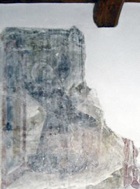


Pace di Bartolo was first documented in Assisi in 1344, when he was working for the Confraternita di Santo Stefano. A document of 1363 records a payment made to “Pace di Bartuolo” for the frescoes in a tabernacle in Vicolo Santo Stefano. This tabernacle still exists (as illustrated above), together with fragments of the original decoration (see below). He was documented again in 1367, when he was paid for painting the arms of Pope Urban V and Assisi on some of the city gates (including those that survive on Porta San Francesco - see below). By this time, he had become a citizen of Assisi.
Scenes from the Life of Sant’ Antonio Abate (ca. 1354)
According to Giorgio Vasari, a Duke of Spoleto commissioned these frescos from “Pace da Faenza” for the Cappella di Sant’ Antonio Abate in the Lower Church of San Francesco. (Fra Ludovico da Pietralunga reports their existence, but offers no other information about them). The duke in question was presumably Blasco Fernandez di Belviso, (as set out in the page on San Francesco in the 14th century). The frescoes may have been associated with a payment made in 1354 to an artist called Pace, which is recorded in the archives of the Sacro Convento: this artist was probably Pace di Bartolo. The frescoes no longer survive.
Frescoes (1363)
As noted above, “Pace di Bartuolo” was paid for painting frescoes in this tabernacle in Vicolo Santo Stefano (see Walk III) in 1363. The surviving fragments from this project depict”
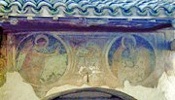
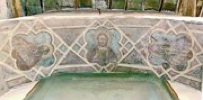
-
✴the Annunciation (above the arch);
-
✴the Redeemer with prophets (under the arch); and
-
✴SS John the Baptist and Catherine of Alexandria (to the sides).
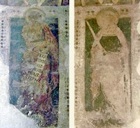
Frescoes (1367)

Frescoes (14th century)
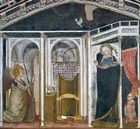
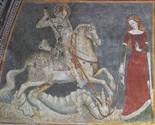
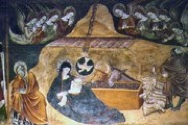
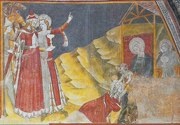
These frescoes on the left wall of the 1st bay in the Cappella di San Giorgio, Santa Chiara, which are attributed to Pace di Bartolo, depict:the Annunciation, with a kneeling donor to the right who seems to have been a young noble woman (in the lunette);
-
✴St George (the titular of the chapel) saving the princess from the dragon (on the left);
-
✴the Madonna feeding the Child before the manger as the Holy Spirit descends, with St Joseph asleep on the left and the angel appearing to the shepherds to the right; and
-
✴the Adoration of the Magi, in which the Child lays His hand on the head of one of the kings while St Francis looks on from the right, holding a chalice that portends the Crucifixion.
Pope Urban V (14th century)
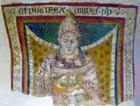
Frescoes (14th century)
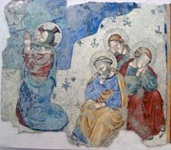
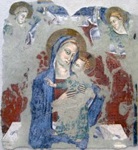
Two works from the Oratorio di San Crispino that are attributed to Pace di Bartolo are now in the Pinacoteca Comunale. They depict:
-
✴the agony in the garden; and
-
✴a fragment of the Madonna and Child with angels.
Frescoes (14th century)
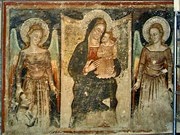

These two frescoes, which are attributed to Pace di Bartolo, were detached from the Oratorio della Confraternita di San Rufinuccio in 1955 and are now in the Museo Diocesano:
-
✴The better preserved depicts the Madonna and Child flanked by two angels, each of which commends a donor.
-
✴The other, which depicts the head of Christ and that of an angel, was probably part of a representation of the agony of Christ in the Garden of Gethsemane.
Frescoes in Santa Maria Maggiore (14th century)

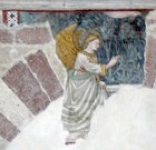
The frescoes in Santa Maria Maggiore are attributed to Pace di Bartolodepict:
-
✴the Madonna and Child (under the 3rd arch on the left); and
-
✴lovely figure of the angel of the Annunciation on the left wall of the presbytery, which was recovered after the 1997 earthquake and then restored.
Frescoes in San Pietro (14th century)
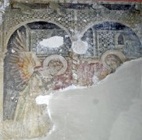
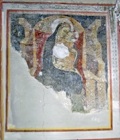

These damaged frescoes in the Cappella del Sacramento of San Pietro are attributed to Pace di Bartolo. They depict:
-
✴the Annunciation (to the left on the back wall);
-
✴the Madonna and Child (to the right on the back wall); and
-
✴St Victorinus (on the right wall).
Annunciation (14th century)

These large fresco fragments, which came from the Oratorio di San Gregorio and are now in the Pinacoteca Comunale, are attributed to Pace di Bartolo. Elvio Lunghi (referenced below, p. 286, entry 118) suggested that Puccio Capanna completed the figure of the angel.
Stigmatisation of St Francis (14th century)
